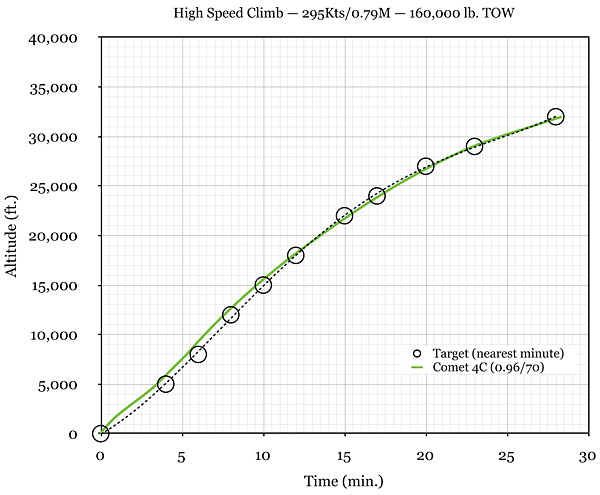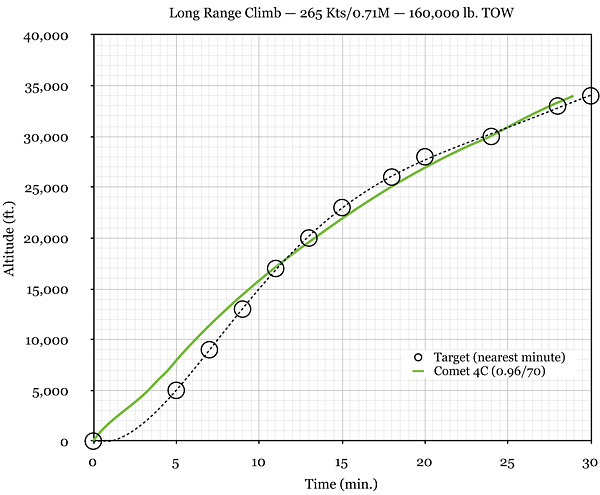Comet 4c - Performance
20/10/12 10:00
Performance tuning for the Comet 4C in X-Plane 9.70 is finished.
There are several discrepancies between data published in the Flight Operating Data manual and X-Plane performance. For example weight, which affects performance more than it did for the real aircraft. I’ve decided that someone doing a quick hop for fun is less likely to be concerned about timing and fuel consumption than someone flying a historic route over 5-6 hours, so the model is optimised for heavy loads.
Climb
The charts show climb performance at close to maximum take-off weight. Don’t pay too much attention to the exact shape of the target trend line: software was occasionally confused by DH data being rounded to the nearest minute.
Cruise
Cruise performance was tested between 25,000-40,000 feet, and weights from 105,000-155,000 lb (or the maximum limit for a particular altitude and speed). Results across the whole spectrum were as follows:
At the real Comet’s optimum economic cruise of 0.76M @ 35,000 feet, fuel consumption of the model is approximately 3% lower than it should be. I considered raising fuel consumption by 2% across the board, but this would have made the model marginally too thirsty in some situations. I think it is better for people to find they have slightly more in reserve than anticipated than to run short.
Holding Patterns
“Holding Pattern” in the DH Flight Operating Data is listed at 215 Kts, with tables ranging from 2,000 feet to 26,000 feet at 2,000 feet intervals. These were checked, and the model is an average of 3% less than the real Comet 4C, (max 0%; min -4.7%).
Descent
Descent is the least accurate part of the model’s overall performance. High speed descents take 24 minutes (2 minutes too long) while long range descents take 31 minutes (5 minutes too short). Obviously, increasing the model’s drag to improve one would make the other worse, so there is not a lot that can be done. However, since the amount of fuel consumed during descent is a small proportion of fuel used over an entire journey, it’s not worth compromising climb or cruise performance to improve descent. For example, the most serious error here equates to a 450 lb. error in fuel used, which would be 4% overall error on a flight from London to Frankfurt, or less than 1% from London to New York.
Qualitative Handling
Stall speeds in clean configuration and flaps set to 20º are spot-on. Unstick speeds guarantee that the model will reach V2 with a +6º pitch at all weights (pitch can be increased to ≈ 9º after V2 for climb-out). Good landings are straight forward at textbook speeds.


--
GMM-P (20/10/2012)
There are several discrepancies between data published in the Flight Operating Data manual and X-Plane performance. For example weight, which affects performance more than it did for the real aircraft. I’ve decided that someone doing a quick hop for fun is less likely to be concerned about timing and fuel consumption than someone flying a historic route over 5-6 hours, so the model is optimised for heavy loads.
Climb
The charts show climb performance at close to maximum take-off weight. Don’t pay too much attention to the exact shape of the target trend line: software was occasionally confused by DH data being rounded to the nearest minute.
Cruise
Cruise performance was tested between 25,000-40,000 feet, and weights from 105,000-155,000 lb (or the maximum limit for a particular altitude and speed). Results across the whole spectrum were as follows:
- Engine RPM setting
Average: -1.0%; Min: -3.7%; Max: +0.7%. - Fuel consumption
Average: -2.2%; Min: -8.0%; Max +1.4%.
At the real Comet’s optimum economic cruise of 0.76M @ 35,000 feet, fuel consumption of the model is approximately 3% lower than it should be. I considered raising fuel consumption by 2% across the board, but this would have made the model marginally too thirsty in some situations. I think it is better for people to find they have slightly more in reserve than anticipated than to run short.
Holding Patterns
“Holding Pattern” in the DH Flight Operating Data is listed at 215 Kts, with tables ranging from 2,000 feet to 26,000 feet at 2,000 feet intervals. These were checked, and the model is an average of 3% less than the real Comet 4C, (max 0%; min -4.7%).
Descent
Descent is the least accurate part of the model’s overall performance. High speed descents take 24 minutes (2 minutes too long) while long range descents take 31 minutes (5 minutes too short). Obviously, increasing the model’s drag to improve one would make the other worse, so there is not a lot that can be done. However, since the amount of fuel consumed during descent is a small proportion of fuel used over an entire journey, it’s not worth compromising climb or cruise performance to improve descent. For example, the most serious error here equates to a 450 lb. error in fuel used, which would be 4% overall error on a flight from London to Frankfurt, or less than 1% from London to New York.
Qualitative Handling
Stall speeds in clean configuration and flaps set to 20º are spot-on. Unstick speeds guarantee that the model will reach V2 with a +6º pitch at all weights (pitch can be increased to ≈ 9º after V2 for climb-out). Good landings are straight forward at textbook speeds.


--
GMM-P (20/10/2012)
blog comments powered by Disqus
